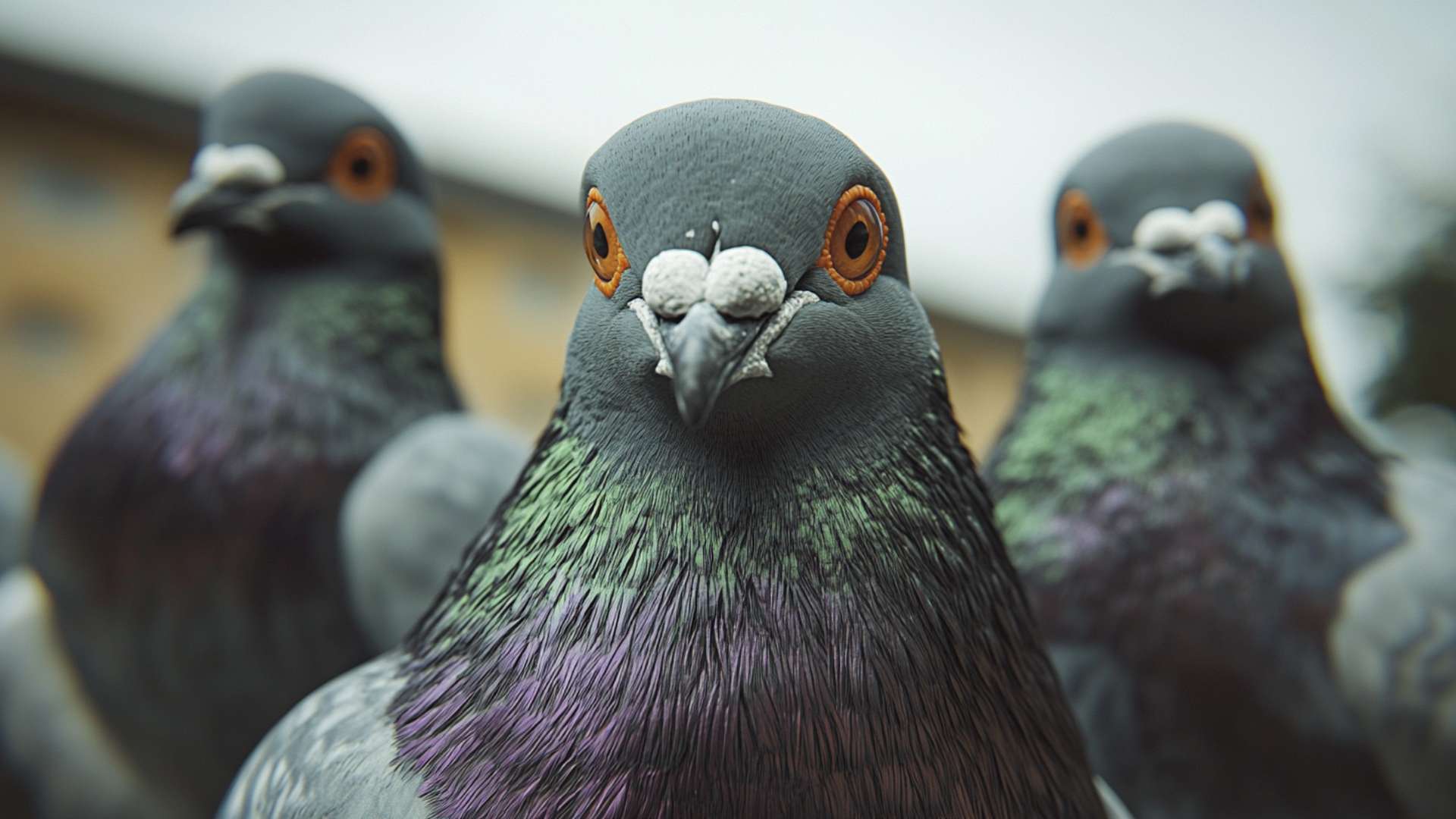When we think of pigeons, we often envision them cooing and fluttering around parks or perched on city buildings. But have you ever wondered what goes on in their romantic lives?
Pigeon mating is an intriguing and essential aspect of their existence. These fascinating birds engage in a range of behaviors during the mating season to find a suitable partner, establish territories, and reproduce.
Overview of pigeon mating behavior
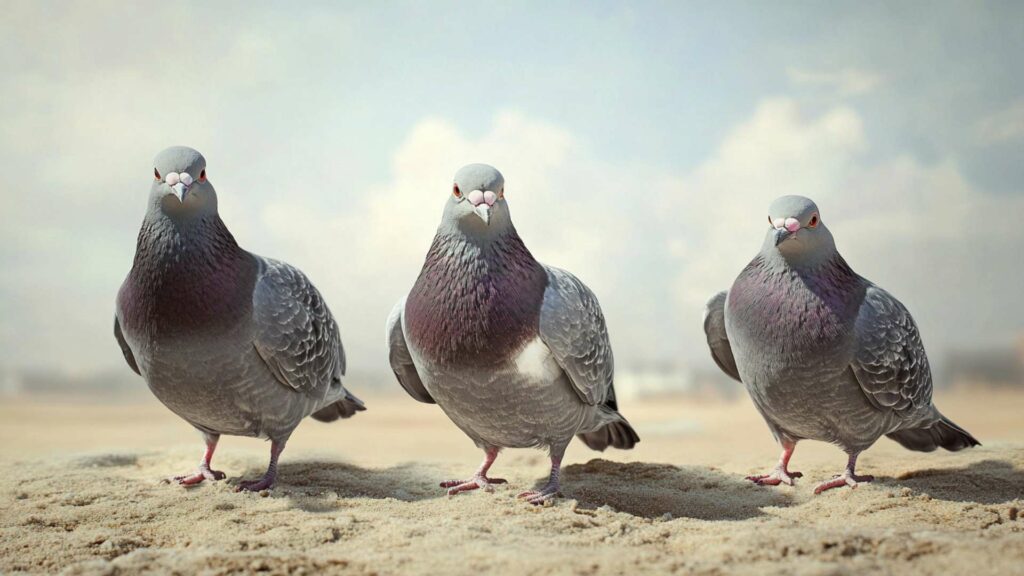
Pigeons are highly social animals that form strong pair bonds during the breeding season. Adult pigeons exhibit remarkable courtship rituals as they search for a mate.
The male pigeon takes center stage in this intricate dance, showcasing his feathers with elaborate displays and striking postures. He bows and coos melodiously, creating an enchanting symphony that echoes through the air.
Not only do they communicate through sound, but they also nod their heads and bob rhythmically to captivate potential partners. The female pigeons play an active role as well, observing these performances keenly before selecting a new mate themselves.
They carefully assess the physical traits and behavioral qualities displayed by the males when making their decision. Once a compatible pairing is established, these amorous avian creatures embark on an adventure together – building nests, producing offspring, and nurturing them with utmost care.
Importance of mating for pigeon population
Mating with baby pigeons plays a pivotal role in maintaining healthy pigeon populations across various species. As loyal partners throughout life, pigeons rely on successful matings to sustain their species’ existence and ensure continuity for future generations. The regular breeding season allows adult pigeons to lay eggs that will eventually hatch into adorable baby pigeons known as squabs.
Pigeon reproduction is vital not only for individual survival but also for ecological balance as they contribute to seed dispersal and pollination processes. Additionally, pigeon mating behaviors offer an opportunity for researchers and wildlife enthusiasts to study and understand avian courtship rituals, enhancing our understanding of animal behavior in general.
In urban settings, where pigeons often coexist with humans, their mating habits can be a source of fascination for city dwellers. It is not uncommon to see these remarkable birds engaging in pigeon sex right before our eyes, reminding us that even amidst the concrete jungle, nature’s wonders persist.
Displaying Feathers and Postures

When it comes to wooing their potential partners, pigeons have perfected the art of visual seduction through the exquisite display of their feathers and postures. During courtship, male pigeons put on a spectacular show by puffing up their chest feathers, raising their necks, and strutting with an air of confidence.
This display not only showcases their physical prowess but also serves as a means of communication to attract females. The vibrant colors and patterns on their feathers act as irresistibly alluring signals, indicating good health and genetic fitness.
Bowing and Cooing Sounds
As if the mesmerizing feather display isn’t enough to captivate the attention of potential mates, male pigeons enhance their courtship rituals with enchanting cooing sounds. This melodic vocalization involves deep resonating coos that reverberate through the air, creating a romantic ambiance.
Alongside these captivating sounds, male pigeons engage in graceful bowing movements that further emphasize their desire for companionship. This synchronized acoustic and physical performance is an essential part of courtship in pigeon society.
Nodding and Head-Bobbing
Pigeons take courtship dances to a whole new level with their charming nodding and head-bobbing rituals. In this enchanting spectacle of avian affection, males rhythmically nod or bob their heads while facing the object of their affection directly. This head movement serves as both a greeting gesture towards the female pigeon they’re interested in and an invitation for her to join them in courtship activities such as preening or feeding together.
The synchrony created by these rhythmic movements displays not only coordination but also signifies compatibility between potential mates. Throughout these elaborate courtship rituals, young pigeons can establish connections with one another based on mutual attraction and compatibility.
By displaying their beautiful feathers, emitting alluring cooing sounds, and engaging in synchronized head movements, these birds create an enchanting spectacle that showcases their charm and courtship prowess. In the fascinating world of pigeons, courtship rituals play a vital role in forming monogamous partnerships that can endure for life, strengthening the bonds between these remarkable birds.
Factors Influencing Mate Choice

When it comes to selecting a mate, pigeons are discerning beings who carefully consider a multitude of factors. Physical traits play a significant role in their decision-making process. Just like us humans, pigeons are drawn to attractive features.
Males with vibrant plumage and distinctive markings often catch the eye of females seeking a partner. These beautiful adornments serve as visual cues, signaling good health and genetic fitness.
Additionally, behavioral characteristics cannot be overlooked; pigeons look for individuals that exhibit confidence, intelligence, and strong nurturing instincts. These qualities can greatly influence their choice of companionship.
The reproductive dance of pigeons is an intricate affair where males must put on quite the show to win over potential mates. The courtship performance becomes an enchanting spectacle as males showcase their agility and grace in mid-air displays.
They gracefully soar through the sky, expertly maneuvering their wings to create mesmerizing patterns and impressive aerial acrobatics. The males lay it all on the line to captivate the attention of females looking for a partner who possesses exceptional physical prowess.
Role of Male’s Courtship Performance
The male pigeon’s courtship performance serves as the ultimate test, proving his worthiness as a mate. It’s not just about dazzling displays; it’s also about demonstrating commitment and dedication to providing for future offspring.
During courtship, he may present food offerings such as seeds or insects to his potential companion – an act known as courtship feeding – symbolizing his ability to provide for her and their future family. This seemingly simple gesture carries profound meaning in the avian world, signifying trust-building between partners-to-be.
It also showcases the male’s superior hunting skills and indicates his readiness for the responsibilities of parenthood. The female pigeon keenly observes these courtship rituals, evaluating the male’s performance and assessing his suitability as a nurturing partner.
In this elaborate dance of love, pigeons create an enchanting symphony of bowing and cooing sounds. The male’s gentle coos resonate through the air, each note carrying a message of affection and devotion.
These melodious sounds are designed to captivate the heart of the female, enticing her to choose him as her lifelong companion. So, next time you spot a pair of pigeons engaged in an intricate courtship ritual, take a moment to appreciate the grandeur behind their seemingly mundane actions.
Their selection process is not based solely on outward appearances but rather on a delicate balance between physical attributes and behavioral traits. It is truly awe-inspiring to witness how love finds its way even among our feathered friends.
Finding Suitable Nesting Sites (e.g., Ledges, Rooftops)
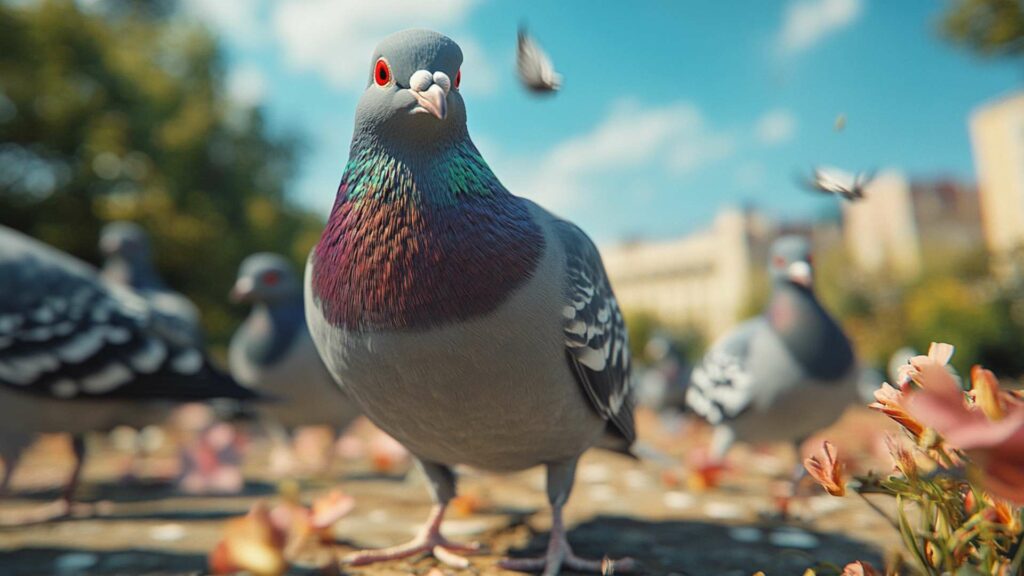
Pigeons are resourceful creatures when it comes to finding suitable nesting sites. They have a knack for adapting to urban environments, often utilizing man-made structures such as ledges and rooftops as their preferred nesting spots. These elevated locations provide the perfect vantage point for the birds to keep an eye on their surroundings while ensuring the safety of their future offspring.
Urban landscapes offer an abundance of choices for pigeon nests. Tall buildings with ledges that jut out or recessed areas provide secure nooks where pigeons can build their homes.
Rooftops also serve as ideal locations due to their secluded nature and protection from ground-dwelling predators. Pigeons, however, are not limited to human-made structures alone; they can also construct nests in natural habitats like cliffs and rock formations.
Building a sturdy nest is crucial for pigeons during the mating season. To accomplish this feat, they diligently collect various materials such as twigs, grass, leaves, and moss.
Pigeons are meticulous gatherers and will scavenge far and wide in search of suitable building materials. The male pigeon takes on the role of a provider during this phase, actively seeking out appropriate nesting materials while displaying his resourcefulness to attract potential mates.
With precision and care, he selects twigs that are strong yet pliable enough for nest construction. Blades of grass are carefully chosen based on length and flexibility to ensure maximum comfort for the future occupants of the the nest site.
Defending Territory Against Intruders
Once a suitable nesting site is secured and construction begins, pigeons become fiercely territorial creatures—especially during breeding season. Both males and females actively defend their chosen spot against other birds attempting to encroach on their territory. They use a combination of vocalizations, physical displays, and assertive behaviors to establish dominance and protect their nesting area.
Males, in particular, take on the role of guardians as they fiercely ward off potential intruders. With puffed-up tail feathers and an intimidating stance, they make it clear to other birds that this territory is claimed.
Aggressive head-bobbing motions serve as a warning sign to any trespassers daring enough to approach. In extreme cases, physical altercations may occur as pigeons battle for control over desirable nesting spots.
Pigeons are remarkable creatures when it comes to nest building and territory establishment during the breeding season. Their ability to adapt to urban environments and utilize man-made structures for nesting is truly impressive.
Through meticulous collection of materials like twigs and grass, they construct nests that provide comfort and security for their young ones. Additionally, the pigeons’ fierce territorial nature ensures that their chosen spot remains inviolable by deterring intruders through display behaviors and vocalizations.
Mating Process
Pigeon courtship is a delightful display of affection and devotion. During the courtship phase, male pigeons go to great lengths to impress their potential mates. One captivating behavior observed in pigeon mating rituals is the male’s courtship feeding.
In an elegant display of chivalry, the male pigeon offers food to his chosen female as a gesture of bonding and nurturing. This act not only showcases his ability to provide for her but also fosters trust and intimacy between the pair.
The courtship feeding behavior involves the male locating food sources and meticulously presenting his findings to the female. This can include seeds, grains, or even small insects that he has gathered diligently.
The female eagerly accepts these offerings, reciprocating with soft cooing sounds, expressing her appreciation for his efforts. This exchange solidifies their bond and strengthens their partnership as they embark on the journey of raising young together.
The Cloacal Kiss: The Physical Act of Mating in Pigeons
When it comes to mating in pigeons, the actual act is an intricate affair known as the cloacal kiss. For accurate understanding, it is important first to comprehend what a cloaca is—a multi-purpose opening located at the rear end of both male and female pigeons through which waste products and sperm are excreted and eggs are laid. During copulation, which typically occurs on elevated structures like rooftops or branches in urban settings, both birds align themselves closely together with their tails touching.
The male then mounts the female from behind while fluttering his wings for balance and support. In this position, their cloacas come into contact with one another in what appears as a gentle kiss—a momentary joining that facilitates sexual reproduction.
The duration of copulation may last anywhere from a few seconds to several minutes. Once completed, the male dismounts, and the female pigeons may engage in mutual preening as they reaffirm their bond.
The successful mating event sets the stage for future nesting and potential egg fertilization. The intricate dance of courtship feeding and cloacal kisses embodies the beauty of pigeon mating rituals.
These behaviors not only ensure the continuation of their species but also serve as a testament to their profound connection and commitment to each other. As we delve further into understanding pigeon reproduction, we will explore their remarkable breeding cycle and shed light on some unique aspects of their behavior that make them truly fascinating creatures.
Pigeon Reproduction Cycle
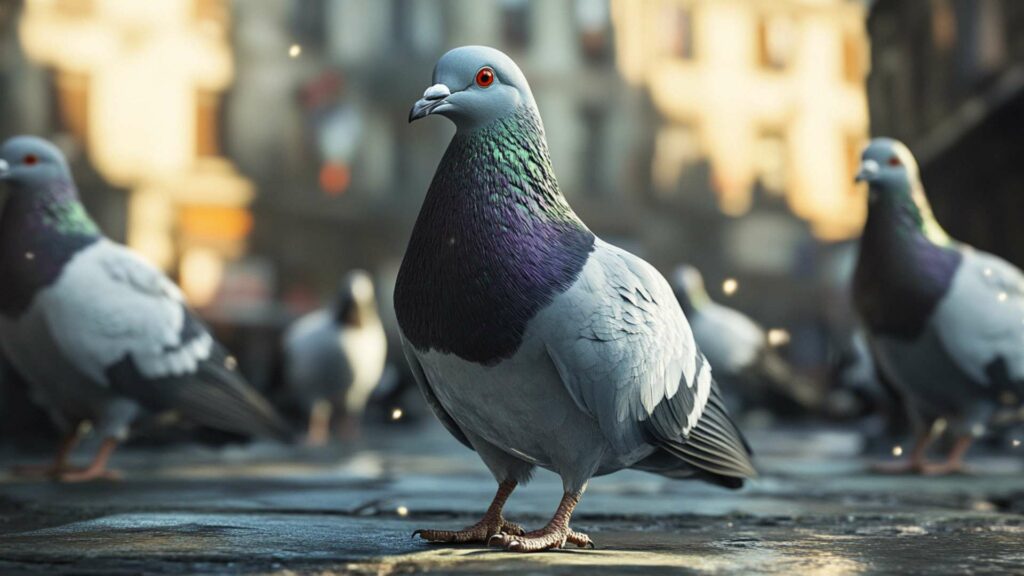
Pigeons, known scientifically as rock doves or rock pigeons, have a well-defined mating season that varies slightly depending on geographical location. In temperate regions, such as Europe and North America, the mating season typically begins in early spring and extends through summer.
This period is characterized by increased courtship displays and vocalizations from male pigeons seeking to attract a suitable mate. Interestingly, pigeons have adapted to urban environments, so you might even witness their romantic pursuits in your backyard or local park.
Once a pair of pigeons has successfully mated, the female will lay eggs to initiate the reproductive process. Pigeons typically lay one or two eggs per clutch, although occasionally three eggs can be observed.
The number of eggs laid most birds may vary depending on factors such as food availability and nesting conditions. Interestingly enough, while some birds lay more eggs to increase their chances of successful reproduction, pigeons have evolved to focus on quality rather than quantity when it comes to their offspring.
Incubation period and shared parental duties
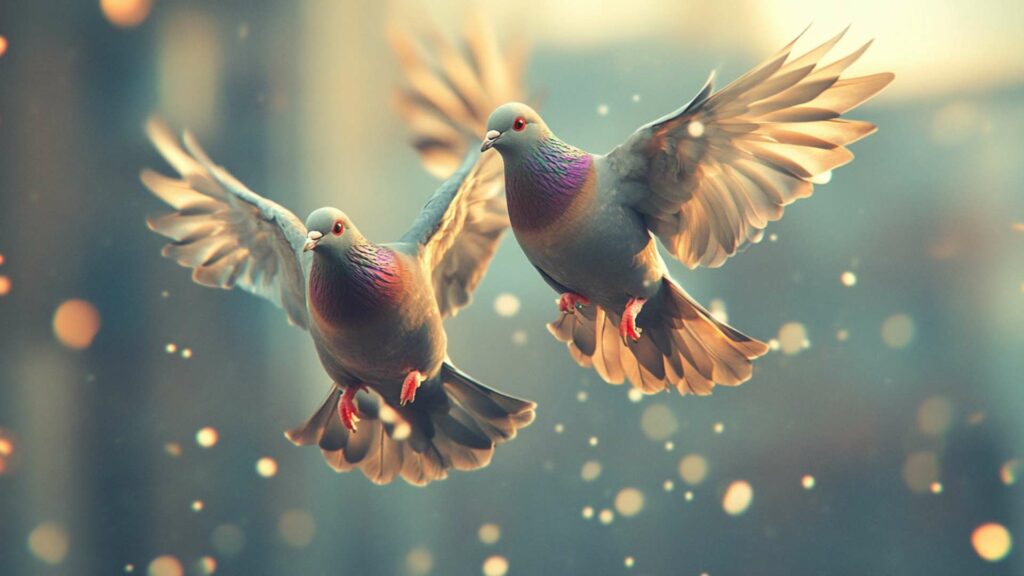
After the female pigeon lays her eggs in a nest made of sticks and twigs (often located in crevices or on ledges), both parents take turns incubating them. The incubation period for pigeon eggs lasts approximately 17 to 19 days. During this time, both parents diligently guard the nest from potential threats like other birds or animals that may pose a danger to their unhatched chicks.
Once the chicks hatch out of their shells with soft down feathers covering their tiny bodies, they are completely dependent on their parents for survival. Both mother and father play active roles in rearing their young ones by taking turns feeding them with regurgitated food rich in nutrients until they are old enough to fly and forage independently.
This shared parental duty highlights the strong bonds that form between pigeon pairs and their commitment to ensuring the success of their offspring. Pigeons adhere to a well-defined reproductive cycle.
The first bird mating season occurs during spring and summer when male pigeons put on elaborate displays to attract a mate. Once paired, female pigeons lay one or two eggs per clutch, which are attentively incubated by both parents for approximately 17 to 19 days.
After hatching, the young chicks receive continuous care from both parents until they gain independence. Understanding these fascinating aspects of pigeon reproduction sheds light on the remarkable behaviors and strategies that ensure the survival of these remarkable birds in our urban environments.
Peculiarities in Pigeon Mating Behavior
When it comes to the realm of love and relationships, pigeons exhibit an intriguing range of mating strategies. While some pigeon species are known for their monogamous tendencies, others embrace a more polygamous lifestyle.
Monogamous pigeons mate for life, forming strong bonds that endure through countless breeding seasons. These devoted pairs build their nests together, raise their young cooperatively, and remain faithful to each other throughout their lives.
On the other wing, there are certain pigeon species that prefer playing the field and explore polygamy. These charismatic avian Casanovas may have multiple mates simultaneously or seek new partners each breeding season.
In these cases, males often engage in elaborate courtship displays to attract females and secure their affections. These displays can involve fluttering feathers, puffed chests, and enchanting cooing sounds that make even the most stoic onlookers swoon.
Same-Sex Pairings: Instances of Homosexual Behavior in Pigeons
The rich tapestry of pigeon mating behavior encompasses not only diverse mating systems but also unexpected instances of same-sex pairings. Yes, you heard it right! Just like humans and various other animal species, pigeons too engage in homosexual behavior.
Researchers have observed same-sex courtship rituals and even long-term partnerships between male or female pigeons. This fascinating aspect challenges the conventional notion that reproductive compatibility solely drives mating choices in animals.
Same-sex pigeon pairs often display similar courtship behaviors to those exhibited by heterosexual couples – gentle bowing movements interspersed with affectionate cooing sounds. While these relationships may not lead to egg-laying or offspring production directly, they provide social companionship for these individuals within the flock.
The world of pigeon mating behavior is a captivating canvas where monogamy and polygamy, as well as same-sex pairings, coexist harmoniously. Whether it’s the unwavering loyalty of monogamous pigeons or the allure of multiple partners embraced by their polygamous counterparts, these behaviors underscore the remarkable diversity in avian relationships.
Moreover, instances of same-sex pairings in pigeons serve as a gentle reminder that love knows no boundaries and can manifest in surprising ways throughout the animal kingdom. So next time you come across a flock of pigeons engaged in courtship rituals, take a moment to appreciate the complexity of their love lives and marvel at nature’s infinite possibilities.
Protection Measures for Breeding Pigeons
In an increasingly urbanized world, conservation efforts play a crucial role in protecting pigeon populations. Though some may consider pigeons to be a common sight, their numbers have been declining in recent years due to various factors.
To combat this decline, numerous organizations and individuals have stepped up to implement measures aimed at preserving these remarkable birds. One such initiative involves creating dedicated pigeon-friendly habitats within urban areas.
By providing suitable nesting sites and a stable platform for breeding, these habitats encourage the proliferation of pigeon populations and offer them a safe space amidst the concrete jungle. Additionally, conservationists work diligently to raise awareness about the importance of pigeons in ecosystems.
Contrary to popular belief, pigeons are not simply “pests” or “nuisances.” They fulfill essential ecological roles by dispersing seeds and contributing to nutrient cycling. Through education programs and public outreach campaigns, conservationists strive to change public perceptions about pigeons and emphasize their significance in maintaining biodiversity.
Threats to Pigeon Breeding Habitats: A Battle for Survival
While conservation efforts aim to protect pigeon populations, it is essential to address the threats they face in their natural habitats. Urbanization poses one of the most significant challenges for these birds. As cities expand and infrastructure development accelerates, wild spaces diminish, leaving little room for pigeons’ nesting activities.
The destruction or removal of potential nesting sites such as ledges on buildings further exacerbates this issue. Another threat comes from predation by introduced species such as feral cats and invasive birds that compete with pigeons for resources.
These predators often target pigeon nests containing vulnerable pigeon eggs or young fledglings. Human activities like excessive use of pesticides can also indirectly impact pigeon populations by reducing the availability of insects and other food sources.
To address these threats, collaboration between various stakeholders is key. Local governments, conservation organizations, and concerned citizens can work hand in hand to protect pigeon breeding habitats.
Implementing regulations to preserve existing nesting sites, creating artificial nest structures within urban areas, and supporting initiatives that promote sustainable urban planning are vital steps toward safeguarding pigeon populations. Furthermore, the importance of public involvement cannot be overstated.
Encouraging individuals to be responsible stewards of backyard birds and their surroundings by refraining from harming pigeons or destroying their nests can make a significant difference. By taking small actions such as providing water and suitable food sources for pigeons in public spaces or even reporting instances of illegal trapping or killing, everyone can contribute to the conservation of these remarkable birds.
Protecting pigeon breeding habitats requires a multi-faceted approach involving conservation efforts and addressing the threats faced by these birds in urban environments. Through dedicated preservation measures such as creating suitable nesting spaces and raising awareness about the ecological role of pigeons, we can ensure their survival for future generations to observe their remarkable mating behaviors and admire their resilience amidst ever-changing landscapes.
Conclusion
Throughout this article, we have delved into the fascinating world of pigeon mating behavior, uncovering the intricate rituals and processes that govern their reproductive lives. From courtship rituals to nest building birds mate, and the actual act of mating, pigeons engage in a series of behaviors that ensure the continuation of their species. One key takeaway is the significance of courtship displays in attracting a mate.
Male pigeons go to great lengths to impress females, showcasing their colorful feathers and engaging in elaborate dances. These displays not only demonstrate physical fitness but also serve as an indicator of a potential mate’s genetic quality.
Another interesting aspect is the monogamous nature of pigeons. Once they find a suitable partner, they form strong bonds and often mate for life.
This level of commitment is admirable, mirroring our own human desires for long-lasting partnerships. We explored some other animals’ peculiarities in pigeon mating behavior such as same-sex pairings and instances of homosexuality.
While this may seem unusual to some, it highlights the diversity present within nature’s tapestry and reminds us that love comes in many different forms. Studying how pigeons mate provides us with valuable insights into their reproductive strategies and behaviors.
By better understanding these processes, we can appreciate the marvels of sexual reproduction while also raising awareness about conservation efforts aimed at protecting these remarkable birds and their habitats. So let us celebrate these majestic creatures as they take flight with hope for a future where the skies are adorned with more pairs of loving pigeons gracefully soaring together.
Discourage Pigeons with D-Termination: The Top Choice for Pest Control in Las Vegas!

Are pigeons causing you problems? D-Termination is here to assist. Our team of experts specializes in pigeon deterrence and the restoration of cleanliness and integrity to your environment. Bid farewell to pigeons today – opt for D-Termination for highly effective pest control.
You can reach us at 702-919-6310 or visit dtermination.com to schedule your pigeon control service and take back your space from these unwelcome pests.
Frequently Asked Questions:
Signs of pigeon mating include cooing, bowing, and billing gestures.
Pigeons are typically monogamous, so same-sex pairing for mating is uncommon.
Pigeons may mate several times a day during their breeding season.
Yes, pigeons often form long-term pairs and stay together after mating.

